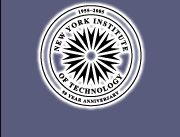 |
||
 |
 |
 |
 |
||
|
|
|
|
|
|
|
 |
 |
 |
About NYIT: New York Institute of Technology is a private coeducational institution of higher learning. Founded in 1955, the college now enrolls over 14,000 students and has graduated over 66,000 alumni. NYIT offers over 60 undergraduate majors and 12 graduate degrees. Known for its hands-on instructional programs, NYIT affords students the opportunity to gain work experience through their coursework. Technology is infused into every program at NYIT. Each curriculum is designed to offer specific technological skills essential to the student's career. NYIT students have access to state-of-the-art computer, laser, medical, art, advertising, architectural, photography, engineering, chemistry, physics, forensic, graphic, television, radio, film, culinary, and teleconferencing laboratories. NYIT's Internet services and Online Campus provide every student with an essential connection to classwork, the library holdings, electronic libraries and databases, e-mail, and the research benefits of the World Wide Web. The college's computer facilities include 43 computer labs with over 430 IBM/IBM-compatible and Apple Macintosh microcomputers. NYIT's library resources include five libraries with 204,803 volumes, 3,346 periodicals, 626,117 microforms, and 47,732 audiovisuals. NYIT's nine inter-campus fiber optic rooms serve over 4,000 students per year. Each room is equipped with ISDN, with over 30 lines connecting NYIT to worldwide video conferencing. http://www.nyit.edu About the NYIT de Seversky Center: The de Seversky Center is located on the pristine campus of New York Institute of Technology (NYIT) at Old Westbury, the midpoint on the fabled Gold Coast stretch of Long Islandís North Shore. At a time of optimism and soaring fortunes, captains of industry built grand showplaces here that offered an easy commute to Manhattan. One of them, Alfred I. du Pont, in 1916 commissioned architect Thomas Hastings of the firm of Carrere & Hastings to design his new Long Island residence. White Eagle, as the neo-classical Georgian mansion was then called, was completed in 1918 at a cost of $1,102,000. Mrs. du Pont, the former Alicia Bradford Maddox, died unexpectedly in 1920. When du Pont remarried, he sold the mansion, in 1926, to Frederick E. and Amy Phipps Guest, who renamed the estate Templeton. Mr. Guest, Winston Churchillís first cousin, was the grandson of the seventh Duke of Marlborough. Mrs. Guest was the daughter of Henry Phipps, Andrew Carnegieís partner in the Carnegie Steel Company. Mrs. Guest stayed on at the estate after her husbandís death in 1937. When her parents gave up their Fifth Avenue residence in Manhattan, she had the marble entry hall and stairs moved to Templeton. Upon her death in 1959, the mansion was passed down to her son, Winston Guest, a well-known international polo player. In 1972, New York Institute of Technology purchased Templeton from the Guest family and renamed it after the famous Russian aviator Alexander P. de Seversky, a member of the NYIT board of trustees who was instrumental in the acquisition. http://www.nyit.edu/resources/restaurant/index.html The Center for Energy, Environment and Economics at NYIT: The purpose of the Center is to conduct research, evaluate policy options and advance environmentally friendly technology in the areas of energy generation, air pollution, water resources, solid waste management and transportation. To do so, Center personnel carry out studies, perform experiments and realize analyses for both the public and private sectors. One of the goals of the Center is dissemination of the results of its efforts. Therefore, and in addition to traditional reporting, it will engage in and promote public education of the issues and, from time to time, the Center holds major conferences on a variety of themes. Finally, and in concert with the School of Engineering at New York Institute of Technology, the Center is a demonstration site for new, energy efficient, alternative, renewable resource technologies. These demonstrations are open to the public, to the governmental sector and to the corporate world so that they all might avail themselves of new and useful systems. http://iris.nyit.edu/set/set1/pages/4Bresearch.htm |
|||
 | ||||
 | ||||
 | ||||
 | ||||
 | ||||
 | ||||
 | ||||
 | ||||
 | ||||
 | ||||
 | ||||
 | ||||
 | ||||
 | ||||
 | ||||
 | ||||
 | ||||
 | ||||
 | ||||
|
|